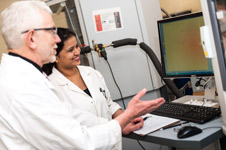The University of Otago's growing ability to be a truly global citizen is the direct result of advances in Information Technology. In the first of a three-part series, the Otago Bulletin Board explores these advances.

Use of the University's computer network is skyrocketing and Otago is ramping up to meet the challenge.
The University's IT links to the world are twice as fast as they were three years ago, Otago's wireless service can cater for up to 26,000 devices simultaneously, and wireless coverage has expanded.
The network's capacity for handling typical daily tasks like using the internet has also more than doubled for staff, students and visitors – from 720 megabits a second to 1803.

Teaching is just one of the uses for IT.
And, there is scope for expansion as demand increases, Information Technology Services (ITS) Infrastructure and Applications Manager Steve Lucas says.
New design features mean the network is better at handling demand at peak times.
“It's all part of taking the brakes off for our users.”
While the University has invested in improvements across the board, the most noticeable benefits will be for people on the new “Future State” network.
It is now at more than 75 locations on the Dunedin, Christchurch and Wellington campuses, including many of the largest academic buildings and four residential colleges.
That network provides enormously faster desktop connections – up to a gigabit a second – so large amounts of data can move very quickly, which is particularly useful for dealing with high definition video, he says.
More than three quarters of the University's wireless service is now directly connected to the “Future State” network as well.

IT access anywhere, anytime, is more important now.
This transformation has been quite a feat considering the size of the network – CIO magazine typically names the University as among the top 10 Information Communication Technology-using organisations in the country.
Mr Lucas likens the changes to a roading network – a multi-lane information highway has replaced the one narrow road that was carrying information to and from the University's campuses.
Large slow-moving “trucks” – packets of data – are also no longer holding up small faster “vehicles” because “lanes” are allocated to specific types of traffic.
The traffic that each has its own individual lane – so its “vehicles” can travel at a consistent speed – includes Google, Eftpos, YouTube, Zoom, and Skype.
Traffic types are also prioritised, so the fastest lanes are for traffic that needs speed the most, for example large amounts of data have to transfer smoothly for Zoom video and web conferencing to provide clear, real-time images.

Connectivity is so important for many things Otago does.
The raft of changes at Otago followed a review of the University's entire network, which had grown organically.
“We had an example where two buildings only 50 metres apart had 1.5 kilometres of network cable between them,” Mr Lucas says. Now that route is simpler, shorter and faster.
The new network can provide even more bandwidth in very special cases. In one example, 10 gigabits a second is being used for a digital microscope camera that takes multiple high definition images a second that are stored in the University's centralised storage on the Dunedin campus.
Previously, staff had to download images from the microscope on to an external disk then manually transfer those images onto long-term storage.
Anyone who has seen work being done on the network in their building but is unsure if their devices are connected to the new “Future State” network should check with their departmental support staff or contact the ITS Service Desk.
Look out for the next two stories in the series, coming to the Otago Bulletin Board tomorrow and Wednesday.